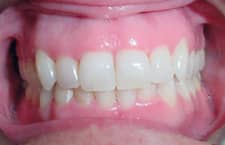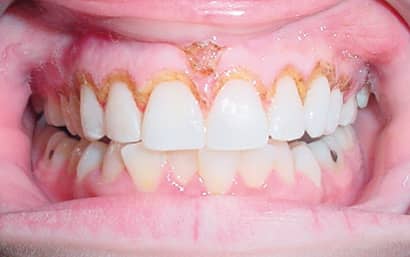How to get patients excited about the benefits of soft-tissue lasers for gingival contouring
By Scott G. Smoron, DDS, MSD
Soft-tissue lasers have been widely adopted in orthodontic practices the last few years. Use of lasers benefit patients in many ways, from improved oral health through the removal of excess gingival tissue to decreased treatment time through better bracket position after gingivectomy. And these benefits to treatment are well recognized by orthodontists and some patients, yet patients are still not excited about the procedure. However, there are soft-tissue laser procedures and outcomes that will get patients excited about laser treatment and their orthodontic treatment and results.
Enthusiasm to Begin
An adult patient with a pleasing smile will typically show 80% or more of the clinical crown of the maxillary anteriors, from 10 to 12 millimeters of enamel. Some patients—in particular, women—will have a millimeter or two of gingival tissue visible, too. The amount of visible gingiva versus the amount of visible clinical crown has a large impact on the perceived beauty of a person’s smile. The percentage of gingival display can be calculated from adding the amount of visible clinical crown to the amount of gingival display. Pleasing smiles will typically have 0% to 20% gingival display and a tooth-to-gingiva ratio of 5:1 or greater.
Patients with a “gummy smile,” or excess gingival display, have more than the normal amount of gingiva showing. They will often present 50% or more gingival display and a tooth-to-gingiva ratio approaching 1:1 or less. Most factors for this increased gingival display can be classified as skeletal, dental, or muscular. Examples of these factors are, respectively, a maxilla with excess vertical growth, maxillary anterior clinical crowns that are not fully exposed, and facial muscles that lift the upper lip higher than average. Diagnosis of the contributing factors is important for discussing treatment options to improve the smile.
Treatment plans for patients with excess gingival display often include options that are unappealing to the majority of patients, such as the use of a high-pull headgear for young patients and surgical impaction of the maxilla for adults. A majority of these patients would indeed benefit from such treatment but are not likely to pursue the treatment or to be compliant with the treatment. The doctor and patient must talk about ideal treatment, reject such treatment, and then decide to pursue a compromised treatment plan with compromised treatment results. It is difficult to enthusiastically embrace a multiyear journey through orthodontic treatment knowing the results are a compromise.
Many adults with excess gingival display choose to pursue a compromised set of treatment goals. However, if one of the contributing factors can be addressed, they may change their perception of their treatment needs. Maxillary clinical crowns that are not fully exposed are a factor that can be addressed separate from any other treatment. For example, a patient with 8 mm of tooth display and 8 mm of gingival display has a 1:1 tooth-to-gums ratio and 50% gingival display. More fully exposing the clinical crown to the normal adult range of 11 mm will reduce the gingival display to a percentage closer to 30% and the tooth-to-gingiva ratio closer to 2:1. The alteration in the ratio can change the patient’s perception of their smile and treatment needs. Excess gingival display remains part of the diagnosis, but it is no longer a chief complaint. The patient can see the improvement and feel confident in rejecting orthognathic jaw surgery. They are able to enjoy their improved smile immediately, and they will have greater enthusiasm for the treatment plan ahead.
Case Study 1
 |
| Figure 1: Patient 1 before lasing with “gummy smile.” |
Treating a patient who presented with excess gingival display and a gingiva to tooth ratio of nearly 1:1, it was noted that she had a “gummy smile” (Figure 1). She explained that she had met with orthodontists in previous years and had discussed orthognathic jaw surgery. However, she never pursued treatment beyond the consultation stage due to her reticence to pursue “jaw surgery.” She was now planning a wedding and was fully committed to orthodontic treatment but unsure about jaw surgery.
After probings, it was clear that at least 2 mm of clinical crown could be exposed through the removal of excess gingival tissue. Removal of the excess tissue was performed prior to a final decision about jaw surgery. Gingivectomy from 2nd premolar to 2nd premolar was performed and allowed to heal for 2 weeks (Figure 2). Upon return to the office, the patient was pleased with her improved smile and had no interest in jaw surgery. She was excited to get started with braces without having to accept a compromised plan or result.
After Treatment: Create a Fan and Save Time
 |
| Figure 2: Patient 1 with improved tooth-to-gingiva ratio. |
Patients seek out orthodontists to improve their smile when their teeth are “crooked.” Both the patient and the orthodontist see the obviously displaced teeth, and the focus of treatment becomes aligning the teeth. The treatment journey begins, and the patient has only a partial understanding and visualization of how the gingival tissues will change.
Orthodontists see and anticipate many gingival changes as treatment progresses, such as gingival embrasures that open and gingival heights that normalize or worsen. Negative changes—such as open gingival embrasures—can be addressed by orthodontists with well-established solutions, such as interproximal reduction. Other problems are often not addressed until the completion of treatment, when a patient no longer sees crooked teeth but now notices other flaws—some that have been present all along. Gingival margins that are not symmetrical or simply not esthetic can become obvious after alignment of teeth and the completion of orthodontic treatment.
A referral to a periodontist was the typical means of addressing the esthetics of the soft tissues prior to adoption of soft-tissue lasers. Most patients never pursued the referral, and many who did never scheduled the treatment due to cost or fear of pain. At subsequent retention visits a discussion about the possibilities of seeing a periodontist, how the periodontist could improve the soft tissues, the discomfort involved, etc, would be repeated and noted in the chart—a time-consuming activity. Notes to dentists and to periodontists would need to be generated about the discussion.
A soft-tissue laser makes it possible to address the esthetic issue in less time than the conversation may take. In fact, the procedure can take 5 minutes of chairtime or less, equivalent to the time spent prepping and bonding a broken bracket. Furthermore, the procedure is so easy that patients are willing, even excited, to repeat the procedure to improve the details further. The orthodontist is able to look like a hero by improving the outcome of treatment in ways the patient never anticipated.
Case Study 2
 |
| Figure 3: Patient 2 before aligners. |
A patient presented with crowding, which she wanted corrected (Figure 3); aligner treatment was utilized to correct the rotations and alignment of her teeth. She was happy with the alignment and treatment provided, but she was not thrilled with her smile. She felt she had “horse teeth.” Photos demonstrated a minimal gingival arc across all her maxillary incisors, producing a clinical crown appearance that was square or like “Chiclets” (Figure 4). The gingival contours were not symmetrical, and there was excess gingival display. The gingival esthetics compromised her desired improvement in her smile.
 |
| Figure 4: Patient 2 after aligners. Note square clinical crown appearance. |
Upon probing, it was discovered there was excess tissue that could be removed. The patient was an attorney, and she wanted to approach the situation conservatively. Topical anesthetic was used, and the maxillary anterior gingival contours were altered. Upon healing, there was an improvement. The patient was excited about the conservative approach and the results. She thought the procedure was so easy that she was interested in pursuing further tissue reduction. A couple of minutes of topical and less than a minute of lasing produced further improvement.
 |
| Figure 5: Patient 2 exhibits improved gingival contours following soft-tissue laser use. |
Finally, after a couple more weeks of additional healing, a final round of lasing was performed just as a final touch-up. Chairtime for each procedure was minimal and produced increasing patient excitement about her treatment. After healing, the patient was thrilled with her smile (Figure 5).
Conclusion
The examples above show how use of a soft-tissue laser can help a patient embrace a treatment plan or generate increased satisfaction with treatment results. Some patients will no longer feel they are pursuing compromised treatment results, and other patients will find something beyond just straight teeth in their new smile. Asking a patient the simple question, “What do you think about your gums?” can lead to soft-tissue procedures that can lead to more satisfied, enthusiastic patient experiences. OP
 |
Scott G. Smoron, DDS, MSD, is in private practice in Mount Prospect, Ill. He completed his dental degree at Northwestern University and his Masters of Science in Dentistry at Saint Louis University. The diode laser has brought joy to his practice, and he exposes nearly every impaction himself. He loves to answer questions about the laser via [email protected]. |











